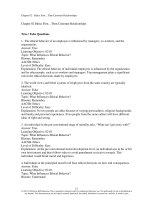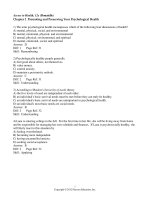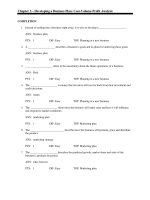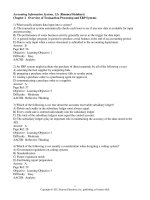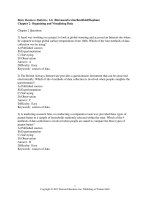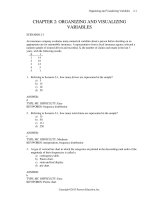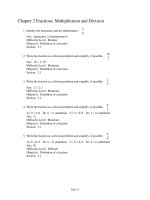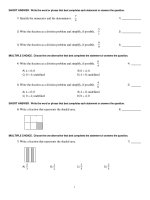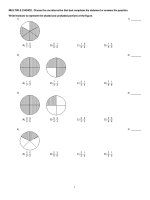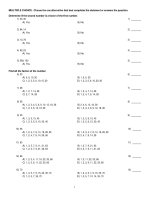Basic business statistics 12th edition berenson test bank
Bạn đang xem bản rút gọn của tài liệu. Xem và tải ngay bản đầy đủ của tài liệu tại đây (1.19 MB, 51 trang )
Basic Business Statistics, 12e (Berenson/Levine/Krehbiel/Stephan)
Chapter 2 Organizing and Visualizing Data
Chapter 2 Questions
1) Jared was working on a project to look at global warming and accessed an Internet site where
he captured average global surface temperatures from 1866. Which of the four methods of data
collection was he using?
A) Published sources
B) Experimentation
C) Surveying
D) Observation
Answer: A
Difficulty: Easy
Keywords: sources of data
2) The British Airways Internet site provides a questionnaire instrument that can be answered
electronically. Which of the 4 methods of data collection is involved when people complete the
questionnaire?
A) Published sources
B) Experimentation
C) Surveying
D) Observation
Answer: C
Difficulty: Easy
Keywords: sources of data
3) A marketing research firm, in conducting a comparative taste test, provided three types of
peanut butter to a sample of households randomly selected within the state. Which of the 4
methods of data collection is involved when people are asked to compare the three types of
peanut butter?
A) Published sources
B) Experimentation
C) Surveying
D) Observation
Answer: B
Difficulty: Easy
Keywords: sources of data
1
Copyright © 2012 Pearson Education, Inc. Publishing as Prentice Hall
4) Tim was planning for a meeting with his boss to discuss a raise in his annual salary. In
preparation, he wanted to use the Consumer Price Index to determine the percentage increase in
his real (inflation-adjusted) salary over the last three years. Which of the 4 methods of data
collection was involved when he used the Consumer Price Index?
A) Published sources
B) Experimentation
C) Surveying
D) Observation
Answer: A
Difficulty: Easy
Keywords: sources of data
5) Which of the 4 methods of data collection is involved when a person counts the number of
cars passing designated locations on the Los Angeles freeway system?
A) Published sources
B) Experimentation
C) Surveying
D) Observation
Answer: D
Difficulty: Moderate
Keywords: sources of data
6) A statistics student found a reference in the campus library that contained the median family
incomes for all 50 states. She would report her data as being collected using
A) a designed experiment.
B) observational data.
C) a random sample.
D) a published source.
Answer: D
Difficulty: Easy
Keywords: sources of data
7) The personnel director at a large company studied the eating habits of the company's
employees. The director noted whether employees brought their own lunches to work, ate at the
company cafeteria, or went out to lunch. The goal of the study was to improve the food service at
the company cafeteria. This type of data collection would best be considered as
A) an observational study.
B) a designed experiment.
C) a random sample.
D) a quota sample.
Answer: A
Difficulty: Easy
Keywords: sources of data
2
Copyright © 2012 Pearson Education, Inc. Publishing as Prentice Hall
8) A study attempted to estimate the proportion of Florida residents who were willing to spend
more tax dollars on protecting the beaches from environmental disasters. Twenty-five hundred
Florida residents were surveyed. What type of data collection procedure was most likely used to
collect the data for this study?
A) A designed experiment
B) A published source
C) A random sample
D) Observational data
Answer: C
Difficulty: Easy
Keywords: sources of data
TABLE 2-1
An insurance company evaluates many numerical variables about a person before deciding on an
appropriate rate for automobile insurance. A representative from a local insurance agency
selected a random sample of insured drivers and recorded, X, the number of claims each made in
the last 3 years, with the following results.
X
1
2
3
4
5
f
14
18
12
5
1
9) Referring to Table 2-1, how many drivers are represented in the sample?
A) 5
B) 15
C) 18
D) 50
Answer: D
Difficulty: Easy
Keywords: frequency distribution
10) Referring to Table 2-1, how many total claims are represented in the sample?
A) 15
B) 50
C) 111
D) 250
Answer: C
Difficulty: Moderate
Keywords: interpretation, frequency distribution
3
Copyright © 2012 Pearson Education, Inc. Publishing as Prentice Hall
11) A type of vertical bar chart in which the categories are plotted in the descending rank order
of the magnitude of their frequencies is called a
A) contingency table.
B) Pareto chart.
C) stem-and-leaf display.
D) pie chart.
Answer: B
Difficulty: Easy
Keywords: Pareto chart
TABLE 2-2
At a meeting of information systems officers for regional offices of a national company, a survey
was taken to determine the number of employees the officers supervise in the operation of their
departments, where X is the number of employees overseen by each information systems officer.
X
1
2
3
4
5
f
7
5
11
8
9
12) Referring to Table 2-2, how many regional offices are represented in the survey results?
A) 5
B) 11
C) 15
D) 40
Answer: D
Difficulty: Easy
Keywords: interpretation, frequency distribution
13) Referring to Table 2-2, across all of the regional offices, how many total employees were
supervised by those surveyed?
A) 15
B) 40
C) 127
D) 200
Answer: C
Difficulty: Moderate
Keywords: interpretation, frequency distribution
4
Copyright © 2012 Pearson Education, Inc. Publishing as Prentice Hall
14) The width of each bar in a histogram corresponds to the
A) differences between the boundaries of the class.
B) number of observations in each class.
C) midpoint of each class.
D) percentage of observations in each class.
Answer: A
Difficulty: Easy
Keywords: frequency distribution
TABLE 2-3
Every spring semester, the School of Business coordinates a luncheon with local business leaders
for graduating seniors, their families, and friends. Corporate sponsorship pays for the lunches of
each of the seniors, but students have to purchase tickets to cover the cost of lunches served to
guests they bring with them. The following histogram represents the attendance at the senior
luncheon, where X is the number of guests each graduating senior invited to the luncheon and f is
the number of graduating seniors in each category.
15) Referring to the histogram from Table 2-3, how many graduating seniors attended the
luncheon?
A) 4
B) 152
C) 275
D) 388
Answer: C
Explanation: C) The number of graduating seniors is the sum of all the frequencies, f.
Difficulty: Difficult
Keywords: interpretation, histogram
5
Copyright © 2012 Pearson Education, Inc. Publishing as Prentice Hall
16) Referring to the histogram from Table 2-3, if all the tickets purchased were used, how many
guests attended the luncheon?
A) 4
B) 152
C) 275
D) 388
Answer: D
Explanation: D) The total number of guests is i6 l Xiƒi
Difficulty: Difficult
Keywords: interpretation, histogram
17) A professor of economics at a small Texas university wanted to determine what year in
school students were taking his tough economics course. Shown below is a pie chart of the
results. What percentage of the class took the course prior to reaching their senior year?
A) 14%
B) 44%
C) 54%
D) 86%
Answer: D
Difficulty: Easy
Keywords: interpretation, pie chart
18) When polygons or histograms are constructed, which axis must show the true zero or
"origin"?
A) The horizontal axis
B) The vertical axis
C) Both the horizontal and vertical axes
D) Neither the horizontal nor the vertical axis
Answer: B
Difficulty: Easy
Keywords: polygon, histogram
6
Copyright © 2012 Pearson Education, Inc. Publishing as Prentice Hall
19) When constructing charts, the following is plotted at the class midpoints:
A) frequency histograms.
B) percentage polygons.
C) cumulative percentage polygon (ogives).
D) All of the above.
Answer: B
Difficulty: Easy
Keywords: percentage polygons
TABLE 2-4
A survey was conducted to determine how people rated the quality of programming available on
television. Respondents were asked to rate the overall quality from 0 (no quality at all) to 100
(extremely good quality). The stem-and-leaf display of the data is shown below.
Stem
3
4
5
6
7
8
9
Leaves
24
03478999
0112345
12566
01
2
20) Referring to Table 2-4, what percentage of the respondents rated overall television quality
with a rating of 80 or above?
A) 0
B) 4
C) 96
D) 100
Answer: B
Difficulty: Easy
Keywords: stem-and-leaf display, interpretation
21) Referring to Table 2-4, what percentage of the respondents rated overall television quality
with a rating of 50 or below?
A) 11
B) 40
C) 44
D) 56
Answer: C
Difficulty: Moderate
Keywords: stem-and-leaf display, interpretation
7
Copyright © 2012 Pearson Education, Inc. Publishing as Prentice Hall
22) Referring to Table 2-4, what percentage of the respondents rated overall television quality
with a rating from 50 through 75?
A) 11
B) 40
C) 44
D) 56
Answer: D
Difficulty: Moderate
Keywords: stem-and-leaf display, interpretation
TABLE 2-5
The following are the duration in minutes of a sample of long-distance phone calls made within
the continental United States reported by one long-distance carrier.
Time (in Minutes)
0 but less than 5
5 but less than 10
10 but less than 15
15 but less than 20
20 but less than 25
25 but less than 30
30 or more
Relative
Frequency
0.37
0.22
0.15
0.10
0.07
0.07
0.02
23) Referring to Table 2-5, what is the width of each class?
A) 1 minute
B) 5 minutes
C) 2%
D) 100%
Answer: B
Difficulty: Easy
Keywords: class interval, relative frequency distribution
24) Referring to Table 2-5, if 1,000 calls were randomly sampled, how many calls lasted under
10 minutes?
A) 220
B) 370
C) 410
D) 590
Answer: D
Difficulty: Moderate
Keywords: relative frequency distribution, interpretation
8
Copyright © 2012 Pearson Education, Inc. Publishing as Prentice Hall
25) Referring to Table 2-5, if 100 calls were randomly sampled, how many calls lasted 15
minutes or longer?
A) 10
B) 14
C) 26
D) 74
Answer: C
Difficulty: Moderate
Keywords: relative frequency distribution, interpretation
26) Referring to Table 2-5, if 10 calls lasted 30 minutes or more, how many calls lasted less than
5 minutes?
A) 10
B) 185
C) 295
D) 500
Answer: B
Difficulty: Moderate
Keywords: relative frequency distribution, interpretation
27) Referring to Table 2-5, what is the cumulative relative frequency for the percentage of calls
that lasted under 20 minutes?
A) 0.10
B) 0.59
C) 0.76
D) 0.84
Answer: D
Difficulty: Easy
Keywords: cumulative relative frequency
28) Referring to Table 2-5, what is the cumulative relative frequency for the percentage of calls
that lasted 10 minutes or more?
A) 0.16
B) 0.24
C) 0.41
D) 0.90
Answer: C
Difficulty: Moderate
Keywords: cumulative relative frequency
9
Copyright © 2012 Pearson Education, Inc. Publishing as Prentice Hall
29) Referring to Table 2-5, if 100 calls were randomly sampled, ________ of them would have
lasted at least 15 minutes but less than 20 minutes.
A) 6
B) 8
C) 10
D) 16
Answer: C
Difficulty: Easy
Keywords: relative frequency distribution, interpretation
30) Referring to Table 2-5, if 100 calls were sampled, ________ of them would have lasted less
than 15 minutes.
A) 26
B) 74
C) 10
D) None of the above
Answer: B
Difficulty: Moderate
Keywords: relative frequency distribution, interpretation
31) Referring to Table 2-5, if 100 calls were sampled, ________ of them would have lasted 20
minutes or more.
A) 26
B) 16
C) 74
D) None of the above
Answer: B
Difficulty: Moderate
Keywords: relative frequency distribution, interpretation
32) Referring to Table 2-5, if 100 calls were sampled, ________ of them would have lasted less
than 5 minutes or at least 30 minutes or more.
A) 35
B) 37
C) 39
D) None of the above
Answer: C
Difficulty: Difficult
Keywords: relative frequency distribution, interpretation
10
Copyright © 2012 Pearson Education, Inc. Publishing as Prentice Hall
33) Which of the following is appropriate for displaying data collected on the different brands of
cars students at a major university drive?
A) A Pareto chart
B) A two-way classification table
C) A histogram
D) A scatter plot
Answer: A
Difficulty: Easy
Keywords: Pareto diagram
34) One of the developing countries is experiencing a baby boom, with the number of births
rising for the fifth year in a row, according to a BBC News report. Which of the following is best
for displaying this data?
A) A Pareto chart
B) A two-way classification table
C) A histogram
D) A time-series plot
Answer: D
Difficulty: Easy
Keywords: time-series plot
35) When studying the simultaneous responses to two categorical questions, you should set up a
A) contingency table.
B) frequency distribution table.
C) cumulative percentage distribution table.
D) histogram.
Answer: A
Difficulty: Easy
Keywords: contingency table
36) Data on 1,500 students' height were collected at a larger university in the East Coast. Which
of the following is the best chart for presenting the information?
A) A pie chart
B) A Pareto chart
C) A side-by-side bar chart
D) A histogram
Answer: D
Difficulty: Easy
Keywords: choice of chart, histogram
11
Copyright © 2012 Pearson Education, Inc. Publishing as Prentice Hall
37) Data on the number of part-time hours students at a public university worked in a week were
collected. Which of the following is the best chart for presenting the information?
A) A pie chart
B) A Pareto chart
C) A percentage table
D) A percentage polygon
Answer: D
Difficulty: Easy
Keywords: choice of chart, percentage polygon
38) Data on the number of credit hours of 20,000 students at a public university enrolled in a
spring semester were collected. Which of the following is the best for presenting the
information?
A) A pie chart
B) A Pareto chart
C) A stem-and-leaf display
D) A contingency table
Answer: C
Difficulty: Easy
Keywords: choice of chart, stem-and-leaf
39) A survey of 150 executives were asked what they think is the most common mistake
candidates make during job interviews. Six different mistakes were given. Which of the
following is the best for presenting the information?
A) A bar chart
B) A histogram
C) A stem-and-leaf display
D) A contingency table
Answer: A
Difficulty: Easy
Keywords: choice of chart, bar chart
40) You have collected information on the market share of 5 different search engines used by
U.S. Internet users in January 2011. Which of the following is the best for presenting the
information?
A) A pie chart
B) A histogram
C) A stem-and-leaf display
D) A contingency table
Answer: A
Difficulty: Easy
Keywords: choice of chart, pie chart
12
Copyright © 2012 Pearson Education, Inc. Publishing as Prentice Hall
41) You have collected information on the consumption by the 15 largest coffee-consuming
nations. Which of the following is the best for presenting the shares of the consumption?
A) A pie chart
B) A Pareto chart
C) A side-by-side bar chart
D) A contingency table
Answer: B
Explanation: B) Even though a pie chart can also be used, the Pareto chart is preferable for
separating the "vital few" from the "trivial many".
Difficulty: Moderate
Keywords: choice of chart, Pareto chart
42) You have collected data on the approximate retail price (in $) and the energy cost per year
(in $) of 15 refrigerators. Which of the following is the best for presenting the data?
A) A pie chart
B) A scatter plot
C) A side-by-side bar chart
D) A contingency table
Answer: B
Difficulty: Easy
Keywords: choice of chart, scatter chart
43) You have collected data on the number of U.S. households actively using online banking
and/or online bill payment from 1995 to 2010. Which of the following is the best for presenting
the data?
A) A pie chart
B) A stem-and-leaf display
C) A side-by-side bar chart
D) A time-series plot
Answer: D
Difficulty: Easy
Keywords: choice of chart, time-series plot
44) You have collected data on the monthly seasonally adjusted civilian unemployment rate for
the United States from 1998 to 2010. Which of the following is the best for presenting the data?
A) A contingency table
B) A stem-and-leaf display
C) A time-series plot
D) A side-by-side bar chart
Answer: C
Difficulty: Easy
Keywords: choice of chart, time-series plot
13
Copyright © 2012 Pearson Education, Inc. Publishing as Prentice Hall
45) You have collected data on the number of complaints for 6 different brands of automobiles
sold in the US in 2006 and in 2010. Which of the following is the best for presenting the data?
A) A contingency table
B) A stem-and-leaf display
C) A time-series plot
D) A side-by-side bar chart
Answer: D
Difficulty: Moderate
Keywords: choice of chart, side-by-side bar chart
46) You have collected data on the responses to two questions asked in a survey of 40 college
students majoring in business What is your gender? (Male = M; Female = F) and What is your
major? (Accountancy = A; Computer Information Systems = C; Marketing = M). Which of the
following is the best for presenting the data?
A) A contingency table
B) A stem-and-leaf display
C) A time-series plot
D) A Pareto chart
Answer: A
Difficulty: Moderate
Keywords: choice of chart, contingency table
TABLE 2-6
A sample of 200 students at a Big-Ten university was taken after the midterm to ask them
whether they went bar hopping the weekend before the midterm or spent the weekend studying,
and whether they did well or poorly on the midterm. The following table contains the result.
Studying for Exam
Went Bar Hopping
Did Poorly in
Did Well in Midterm Midterm
80
20
30
70
47) Referring to Table 2-6, of those who went bar hopping the weekend before the midterm in
the sample, ________ percent of them did well on the midterm.
A) 15
B) 27.27
C) 30
D) 55
Answer: C
Difficulty: Easy
Keywords: contingency table, interpretation
14
Copyright © 2012 Pearson Education, Inc. Publishing as Prentice Hall
48) Referring to Table 2-6, of those who did well on the midterm in the sample, ________
percent of them went bar hopping the weekend before the midterm.
A) 15
B) 27.27
C) 30
D) 50
Answer: B
Difficulty: Easy
Keywords: contingency table, interpretation
49) Referring to Table 2-6, ________ percent of the students in the sample went bar hopping the
weekend before the midterm and did well on the midterm.
A) 15
B) 27.27
C) 30
D) 50
Answer: A
Difficulty: Easy
Keywords: contingency table, interpretation
50) Referring to Table 2-6, ________ percent of the students in the sample spent the weekend
studying and did well on the midterm.
A) 40
B) 50
C) 72.72
D) 80
Answer: A
Difficulty: Easy
Keywords: contingency table, interpretation
51) Referring to Table 2-6, if the sample is a good representation of the population, we can
expect ________ percent of the students in the population to spend the weekend studying and do
poorly on the midterm.
A) 10
B) 20
C) 45
D) 50
Answer: A
Difficulty: Easy
Keywords: contingency table, interpretation
15
Copyright © 2012 Pearson Education, Inc. Publishing as Prentice Hall
52) Referring to Table 2-6, if the sample is a good representation of the population, we can
expect ________ percent of those who spent the weekend studying to do poorly on the midterm.
A) 10
B) 20
C) 45
D) 50
Answer: B
Difficulty: Moderate
Keywords: contingency table, interpretation
53) Referring to Table 2-6, if the sample is a good representation of the population, we can
expect ________ percent of those who did poorly on the midterm to have spent the weekend
studying.
A) 10
B) 22.22
C) 45
D) 50
Answer: B
Difficulty: Moderate
Keywords: contingency table, interpretation
54) In a contingency table, the number of rows and columns
A) must always be the same.
B) must always be 2.
C) must add to 100%.
D) None of the above
Answer: D
Difficulty: Moderate
Keywords: contingency table
16
Copyright © 2012 Pearson Education, Inc. Publishing as Prentice Hall
55) Retailers are always interested in determining why a customer selected their store to make a
purchase. A sporting goods retailer conducted a customer survey to determine why its customers
shopped at the store. The results are shown in the bar chart below. What proportion of the
customers responded that they shopped at the store because of the merchandise or the
convenience?
A) 35%
B) 50%
C) 65%
D) 85%
Answer: C
Difficulty: Easy
Keywords: bar chart, interpretation
TABLE 2-7
The Stem-and-Leaf display below contains data on the number of months between the date a
civil suit is filed and when the case is actually adjudicated for 50 cases heard in superior court.
Stem
1
2
3
4
5
6
Leaves
234447899
22223455678889
0011135778
02345579
112466
158
56) Referring to Table 2-7, locate the first leaf, i.e., the lowest valued leaf with the lowest valued
stem. This represents a wait of ________ months.
Answer: 12
Difficulty: Easy
Keywords: stem-and-leaf display, interpretation
17
Copyright © 2012 Pearson Education, Inc. Publishing as Prentice Hall
57) Referring to Table 2-7, the civil suit with the longest wait between when the suit was filed
and when it was adjudicated had a wait of ________ months.
Answer: 68
Difficulty: Easy
Keywords: stem-and-leaf display, interpretation
58) Referring to Table 2-7, the civil suit with the fourth shortest waiting time between when the
suit was filed and when it was adjudicated had a wait of ________ months.
Answer: 14
Difficulty: Moderate
Keywords: stem-and-leaf display, interpretation
59) Referring to Table 2-7, ________ percent of the cases were adjudicated within the first 2
years.
Answer: 30
Difficulty: Moderate
Keywords: stem-and-leaf display, interpretation
60) Referring to Table 2-7, ________ percent of the cases were not adjudicated within the first 4
years.
Answer: 20
Difficulty: Moderate
Keywords: stem-and-leaf display, interpretation
61) Referring to Table 2-7, if a frequency distribution with equal sized classes was made from
this data, and the first class was "10 but less than 20," the frequency of that class would be
________.
Answer: 9
Difficulty: Easy
Keywords: stem-and-leaf display, interpretation
62) Referring to Table 2-7, if a frequency distribution with equal sized classes was made from
this data, and the first class was "10 but less than 20," the relative frequency of the third class
would be ________.
Answer: 0.20 or 20% or 10/50
Difficulty: Moderate
Keywords: stem-and-leaf display, relative frequency distribution
63) Referring to Table 2-7, if a frequency distribution with equal sized classes was made from
this data, and the first class was "10 but less than 20," the cumulative percentage of the second
class would be ________.
Answer: 46% or 0.46 or 23/50
Difficulty: Moderate
Keywords: stem-and-leaf display, cumulative percentage distribution
18
Copyright © 2012 Pearson Education, Inc. Publishing as Prentice Hall
TABLE 2-8
The Stem-and-Leaf display represents the number of times in a year that a random sample of 100
"lifetime" members of a health club actually visited the facility.
Stem
0
1
2
3
4
5
6
7
8
9
Leaves
012222233333344566666667789999
1111222234444455669999
00011223455556889
0000446799
011345567
0077
8
67
3
0247
64) Referring to Table 2-8, the person who has the largest leaf associated with the smallest stem
visited the facility ________ times.
Answer: 9
Difficulty: Moderate
Keywords: stem-and-leaf display, interpretation
65) Referring to Table 2-8, the person who visited the health club less than anyone else in the
sample visited the facility ________ times.
Answer: 0 or no
Difficulty: Easy
Keywords: stem-and-leaf display, interpretation
66) Referring to Table 2-8, the person who visited the health club more than anyone else in the
sample visited the facility ________ times.
Answer: 97
Difficulty: Easy
Keywords: stem-and-leaf display, interpretation
67) Referring to Table 2-8, ________ of the 100 members visited the health club at least 52
times in a year.
Answer: 10
Difficulty: Moderate
Keywords: stem-and-leaf display, interpretation
68) Referring to Table 2-8, ________ of the 100 members visited the health club no more than
12 times in a year.
Answer: 38
Difficulty: Moderate
Keywords: stem-and-leaf display, interpretation
19
Copyright © 2012 Pearson Education, Inc. Publishing as Prentice Hall
69) Referring to Table 2-8, if a frequency distribution with equal sized classes was made from
this data, and the first class was "0 but less than 10," the frequency of the fifth class would be
________.
Answer: 9
Difficulty: Moderate
Keywords: stem-and-leaf display, frequency distribution
70) Referring to Table 2-8, if a frequency distribution with equal sized classes was made from
this data, and the first class was "0 but less than 10," the relative frequency of the last class
would be ________.
Answer: 4% or 0.04 or 4/100
Difficulty: Moderate
Keywords: stem-and-leaf display, relative frequency distribution
71) Referring to Table 2-8, if a frequency distribution with equal sized classes was made from
this data, and the first class was "0 but less than 10," the cumulative percentage of the next-tolast class would be ________.
Answer: 96% or 0.96 or 96/100
Difficulty: Moderate
Keywords: stem-and-leaf display, cumulative percentage distribution
72) Referring to Table 2-8, if a frequency distribution with equal sized classes was made from
this data, and the first class was "0 but less than 10," the class midpoint of the third class would
be ________.
Answer: 25 or (20+30)/2
Difficulty: Moderate
Keywords: stem-and-leaf display, class midpoint
TABLE 2-9
The frequency distribution below represents the rents of 250 randomly selected federally
subsidized apartments in a small town.
Rent in $
Frequency
300 but less than 400
113
400 but less than 500
85
500 but less than 600
32
600 but less than 700
16
700 but less than 800
4
73) Referring to Table 2-9, ________ apartments rented for at least $400 but less than $600.
Answer: 117
Difficulty: Easy
Keywords: frequency distribution
20
Copyright © 2012 Pearson Education, Inc. Publishing as Prentice Hall
74) Referring to Table 2-9, ________ percent of the apartments rented for $600 or more.
Answer: 8% or 20/250
Difficulty: Easy
Keywords: frequency distribution, cumulative percentage distribution
75) Referring to Table 2-9, ________ percent of the apartments rented for at least $500.
Answer: 20.8% or 52/250
Difficulty: Moderate
Keywords: frequency distribution, cumulative percentage distribution
76) Referring to Table 2-9, the class midpoint of the second class is ________.
Answer: 450
Difficulty: Easy
Keywords: frequency distribution, class midpoint
77) Referring to Table 2-9, the relative frequency of the second class is ________.
Answer: 85/250 or 17/50 or 34% or 0.34
Difficulty: Easy
Keywords: frequency distribution, relative frequency distribution
78) Referring to Table 2-9, the percentage of apartments renting for less than $600 is ________.
Answer: 230/250 or 23/25 or 92% or 0.92
Difficulty: Moderate
Keywords: frequency distribution, cumulative percentage distribution
21
Copyright © 2012 Pearson Education, Inc. Publishing as Prentice Hall
TABLE 2-10
The histogram below represents scores achieved by 200 job applicants on a personality profile.
79) Referring to the histogram from Table 2-10, ________ percent of the job applicants scored
between 10 and 20.
Answer: 20%
Difficulty: Easy
Keywords: histogram, percentage distribution
80) Referring to the histogram from Table 2-10, ________ percent of the job applicants scored
below 50.
Answer: 80%
Difficulty: Moderate
Keywords: histogram, percentage distribution
81) Referring to the histogram from Table 2-10, the number of job applicants who scored
between 30 and below 60 is ________.
Answer: 80
Difficulty: Moderate
Keywords: histogram
82) Referring to the histogram from Table 2-10, the number of job applicants who scored 50 or
above is ________.
Answer: 40
Difficulty: Moderate
Keywords: histogram
22
Copyright © 2012 Pearson Education, Inc. Publishing as Prentice Hall
83) Referring to the histogram from Table 2-10, 90% of the job applicants scored above or equal
to ________.
Answer: 10
Difficulty: Moderate
Keywords: histogram, cumulative percentage distribution
84) Referring to the histogram from Table 2-10, half of the job applicants scored below
________.
Answer: 30
Difficulty: Moderate
Keywords: histogram, cumulative percentage distribution
85) Referring to the histogram from Table 2-10, ________ percent of the applicants scored
below 20 or at least 50.
Answer: 50%
Difficulty: Moderate
Keywords: histogram, cumulative percentage distribution
86) Referring to the histogram from Table 2-10, ________ percent of the applicants scored
between 20 and below 50.
Answer: 50%
Difficulty: Moderate
Keywords: histogram, cumulative percentage distribution
TABLE 2-11
The ordered array below resulted from selecting a sample of 25 batches of 500 computer chips
and determining how many in each batch were defective.
Defects
1
2
17
20
4
21
4
23
5
23
5
25
6
26
7
27
9
27
9
28
12
29
12
29
15
87) Referring to Table 2-11, if a frequency distribution for the defects data is constructed, using
"0 but less than 5" as the first class, the frequency of the "20 but less than 25" class would be
________.
Answer: 4
Difficulty: Easy
Keywords: frequency distribution
88) Referring to Table 2-11, if a frequency distribution for the defects data is constructed, using
"0 but less than 5" as the first class, the relative frequency of the "15 but less than 20" class
would be ________.
Answer: 0.08 or 8% or 2/25
Difficulty: Moderate
Keywords: relative frequency distribution
23
Copyright © 2012 Pearson Education, Inc. Publishing as Prentice Hall
89) Referring to Table 2-11, construct a frequency distribution for the defects data, using "0 but
less than 5" as the first class.
Answer:
Defects
Frequency
0 but less than 5
4
5 but less than 10
6
10 but less than 15
2
15 but less than 20
2
20 but less than 25
4
25 but less than 30
7
Difficulty: Easy
Keywords: frequency distribution
90) Referring to Table 2-11, construct a relative frequency or percentage distribution for the
defects data, using "0 but less than 5" as the first class.
Answer:
Defects
Percentage
0 but less than 5
16
5 but less than 10
24
10 but less than 15
8
15 but less than 20
8
20 but less than 25
16
25 but less than 30
28
Difficulty: Moderate
Keywords: relative frequency distribution, percentage distribution
91) Referring to Table 2-11, construct a cumulative percentage distribution for the defects data if
the corresponding frequency distribution uses "0 but less than 5" as the first class.
Answer:
Defects
CumPct
0
0
5
16
10
40
15
48
20
56
25
72
30
100
Difficulty: Moderate
Keywords: cumulative percentage distribution
24
Copyright © 2012 Pearson Education, Inc. Publishing as Prentice Hall
92) Referring to Table 2-11, construct a histogram for the defects data, using "0 but less than 5"
as the first class.
Answer:
Difficulty: Easy
Keywords: histogram, frequency distribution
25
Copyright © 2012 Pearson Education, Inc. Publishing as Prentice Hall
